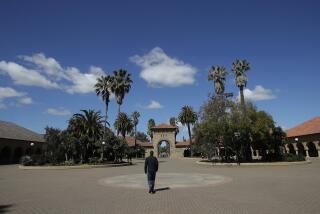EDUCATION : Linking College Enrollment to State Racial Makeup Urged
WASHINGTON â Pointing to an increasingly diverse population that will need college training to fill future jobs, educators recently proposed a national mandate that minority college enrollment reflect each stateâs racial makeup, and that graduation rates be vastly improved.
Each state âmust be responsibleâ for making sure that minority enrollment in higher education is proportional to its population, said Dwayne Matthews, a researcher associated with the Education Commission of the States, a national coalition of education and government officials.
That goal is already exceeded on a nationwide basis for Asian Americans, but a disparity continues to exist among blacks and Latinos. According to 1989 statistics, 11.7% of the U.S. population is black, but only 8.6% of the nationâs 13 million college students are black.
Likewise, Latinos make up 6.4% of the population, but 5.2% of college enrollment. Asians, on the other hand, make up 1.6% of the population and 3.8% of those enrolled in college.
ISSUE: Like the other nine states surveyed, California schools are torn in a âtrade-off between enrollment and graduate rates,â Matthews said.
Enrollment rates can be improved by lowering admission standards so the number of eligible students will increase, thereby raising the minority enrollment. Or, schools can strengthen admission standards to make sure everyone accepted is academically capable of graduating.
A study conducted by the University of California showed that, at doctorate-granting institutions nationwide, only 24% of blacks and 25% of Latinos graduate, compared to a graduation rate of 45% for whites.
To improve graduation rates along with enrollment rates, the outreach must begin when prospective students are still in the seventh and eighth grades, the report said. Tutoring and counseling are also essential in helping minorities who are accepted into higher education institutions to graduate from them as well, the report said.
The task force cited UC Berkeley as âone of the few research universities that has made progress in increasing enrollment and graduation of minority students.â
This year at UC Berkeley, 28.6% of the student body is Asian, 14.5% Latino and 7.2% black. The graduation rate for those ethnic groups is 45% for blacks--a rate that mirrors the nationwide average for whites--57% for Latinos and 71% for Asians.
UC Berkeley provides extra academic help and curriculum guidance to disadvantaged students as early as seventh grade through the schoolâs outreach office and also has special tutoring and workshops designed for minority students.
âThereâs a big pipeline problem we have to address,â said Carolyn Mahoney, a professor at Cal State San Marcos.
OUTLOOK: But persistent problems stand in the way of the task forceâs goals, educators admit. Rising costs paired with dwindling state funds are hampering efforts to bolster minority enrollment and graduation rates.
States should provide incentives to universities to improve their racial balance by giving top priority for funds to colleges and universities with high minority enrollment and graduation rates, the educators said.
But many educators express doubt that the political will exists to spend the time and money needed to create racial balance in the nationâs colleges and universities. Their pessimism grew when the U.S. Department of Education recently challenged the legality of awarding scholarships on the basis of race.
Although the Education Department later backed off on much of its challenge, some education officials feel a symbolism of the governmentâs attitude remains, nevertheless.
Said Frank Newman, president of the education panel, âIt has unconsciously sent a message saying, âYou donât have to worry about this--the achievement of minorities.â â
More to Read
Sign up for Essential California
The most important California stories and recommendations in your inbox every morning.
You may occasionally receive promotional content from the Los Angeles Times.










